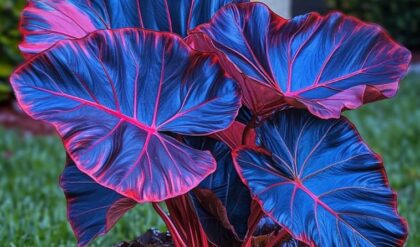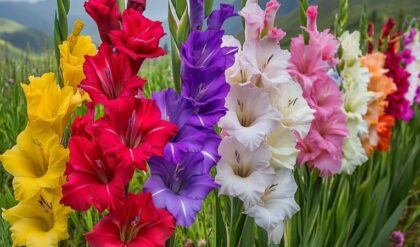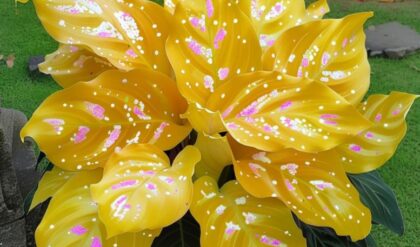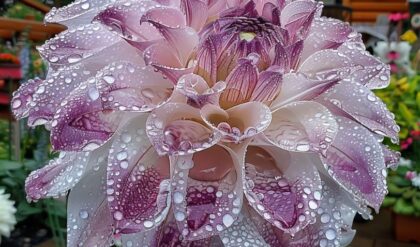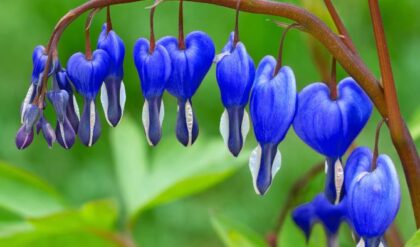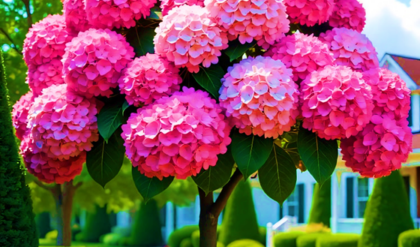The realm of horticulture is replete with awe-inspiring plants, but few capture the imagination quite like Colocasia gigantea ‘Thailand Giant Strain’. This colossal cultivar, commonly known as the elephant’s ear, is not merely a plant; it’s a statement—a testament to the sheer scale and beauty that nature can conjure. Its massive, heart-shaped leaves, capable of reaching astonishing dimensions, transform any garden into a tropical oasis. But the allure of the ‘Thailand Giant Strain’ extends far beyond its remarkable size. It embodies a harmonious blend of aesthetic appeal, ecological significance, and cultural heritage, prompting us to contemplate the interconnectedness between plants, people, and the environment. This exploration delves into the multifaceted world of Colocasia gigantea ‘Thailand Giant Strain’, unveiling its captivating characteristics, ecological implications, cultural roots, and its potential to inspire sustainable gardening practices.
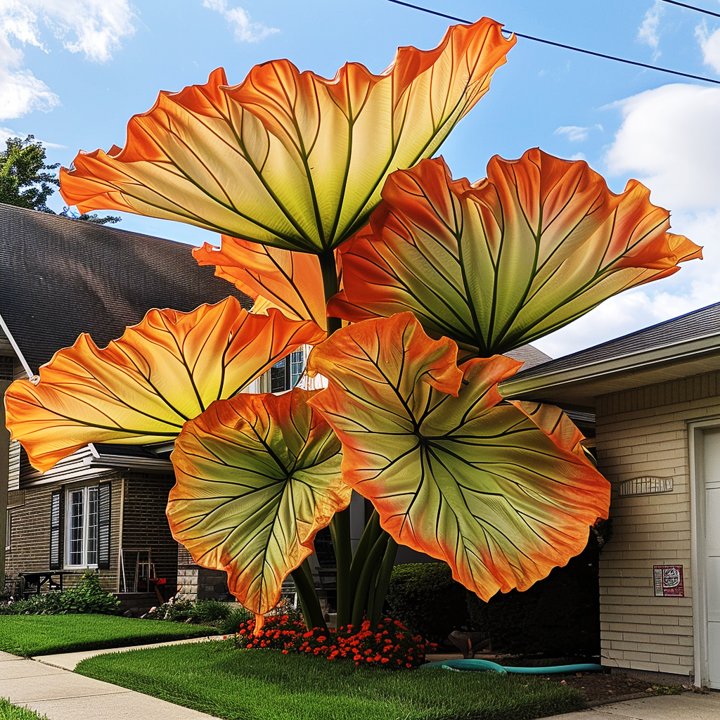
A Colossus of the Plant World: Exploring the ‘Thailand Giant Strain’s’ Physical Attributes
The sheer magnitude of Colocasia gigantea ‘Thailand Giant Strain’ is its most captivating characteristic. It stands as a testament to the power of nature, pushing the boundaries of plant size and capturing hearts with its unparalleled scale. Let’s dive deeper into the features that make this cultivar truly remarkable.
The Majesty of Giant Leaves
The heart-shaped leaves, the defining feature of Colocasia gigantea, reach extraordinary proportions in the ‘Thailand Giant Strain’. These leaves can stretch up to 5 feet in length and 3-5 feet in width, creating a breathtaking visual spectacle. Imagine the sheer impact of these colossal leaves in a garden setting; they transform the landscape, casting an intricate play of light and shadow that evokes a sense of being immersed in a tropical rainforest.
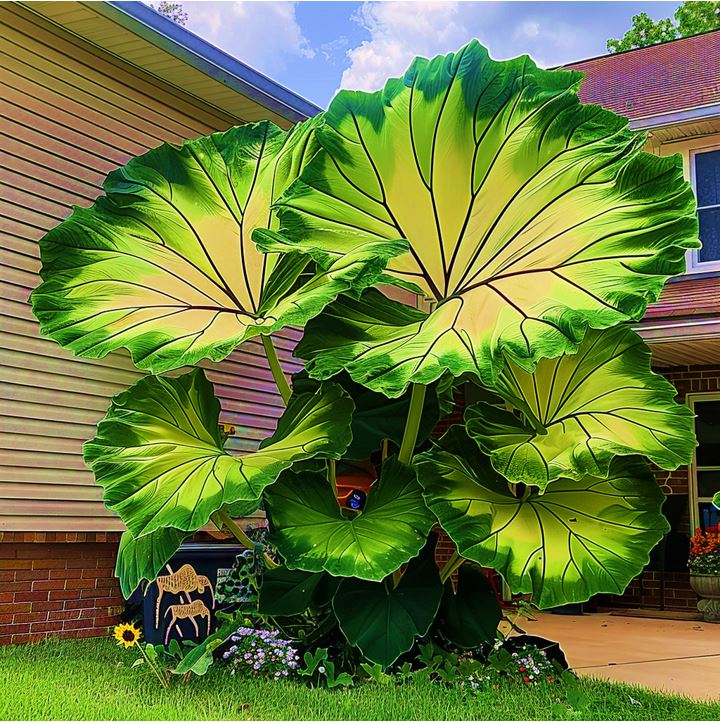
The leaves are not only vast in size but also exhibit a stunning shade of blue-green that adds a vibrant touch to any environment. They provide a cool, almost ethereal quality to the garden, creating a sense of tranquility and serenity. The texture of the leaves is another captivating aspect – smooth and slightly waxy, they feel luxurious to the touch. This adds another layer of sensory experience to the pleasure of observing these magnificent plants.
A Tuberous Giant: The Root System’s Role
Beyond the striking leaves, Colocasia gigantea ‘Thailand Giant Strain’ possesses a robust and substantial tuberous root system. This underground structure acts as a storage organ, accumulating energy and nutrients for the plant’s growth and survival, particularly during periods of stress or dormancy.
The tuber’s size can be impressive as well, reflecting the plant’s overall robust nature. The ability to store a significant amount of energy and water in the tuber helps the plant to withstand periods of drought or unfavorable environmental conditions. Understanding the role of the tuber is crucial for successful cultivation and maintenance of this magnificent species, ensuring proper watering and soil composition for optimal growth.
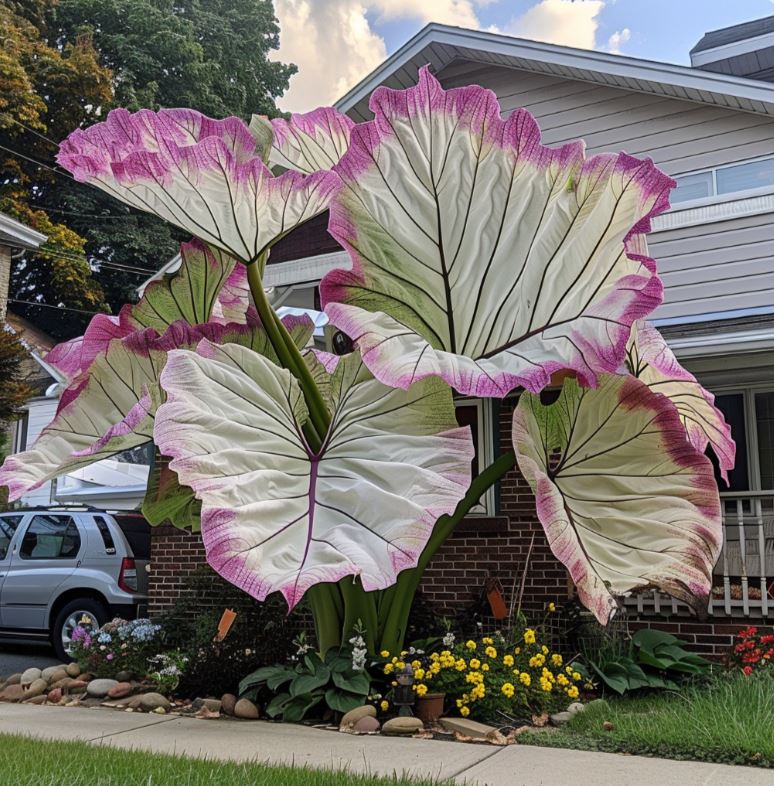
An Architectural Landscape Element
The ‘Thailand Giant Strain’ isn’t simply a plant—it’s a living work of art that can be strategically used to create impactful landscapes. Its sheer size and unique form can be employed to sculpt the garden’s design, establishing focal points, defining spaces, and creating visual barriers.
Consider using these giants to frame a pathway through the garden, or to create a secluded nook or a tranquil resting spot within a backyard oasis. Its large leaves can naturally provide privacy screening, creating a sense of seclusion and intimacy in your outdoor space. The ‘Thailand Giant Strain’ demonstrates how plants can be incorporated as architectural elements, shaping and defining our surroundings with their magnificent scale.
The ‘Thailand Giant Strain’ and Biodiversity: Creating Thriving Ecosystems in the Garden
The ‘Thailand Giant Strain’ doesn’t simply beautify a garden; it actively contributes to a thriving, vibrant ecosystem within the landscape. Its size and characteristics make it a pivotal component in fostering a balanced environment, attracting an array of smaller organisms and creating a sanctuary for life.
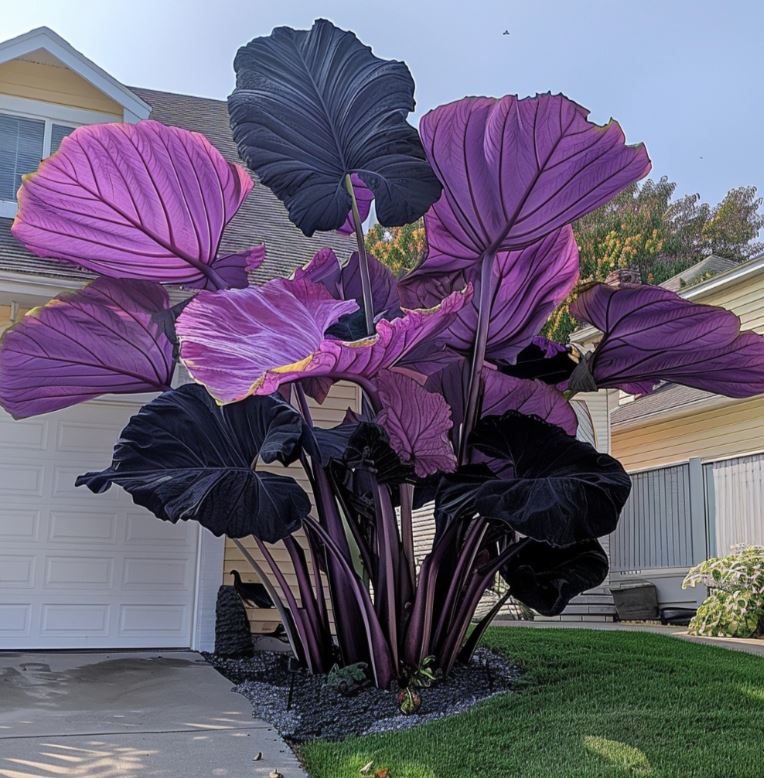
An Umbrella of Shelter: Supporting Other Lifeforms
The vast leaves of Colocasia gigantea ‘Thailand Giant Strain’ act as a natural umbrella, providing vital shade for plants and animals that thrive in understory environments. This creates a microclimate within the garden, offering protection from harsh sunlight and fluctuating temperatures.
Smaller plants, particularly those preferring shade, can thrive under the canopy created by these colossal leaves. This creates a rich tapestry of plant life, promoting biodiversity and ecological balance. The provision of shade also helps to regulate the temperature and humidity levels within the garden, creating a conducive atmosphere for a greater variety of plants.
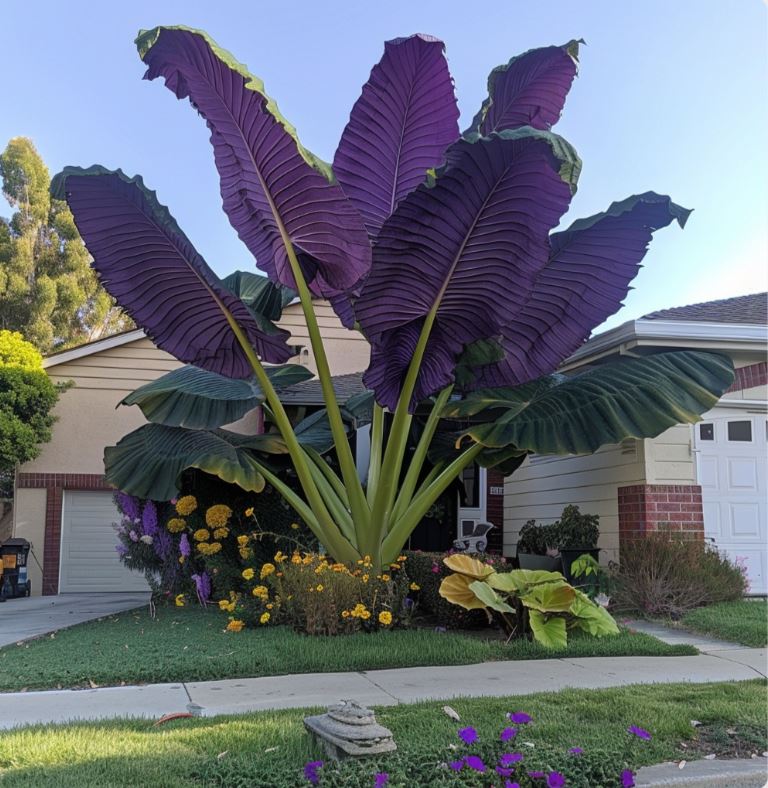
A Haven for Wildlife: Attracting a Symphony of Creatures
The dense foliage and the sheltered environment created by the ‘Thailand Giant Strain’ attract a diverse range of insects, birds, and small mammals. Invertebrates find refuge in the damp, humid areas around the base of the plants, and the leaves provide food and shelter for numerous insect species.
Birds might build nests in the protective cover of the leaves, and small mammals can find shelter amongst the vegetation. The garden becomes a microcosm of life, pulsing with activity and exhibiting a truly diverse range of organisms, all thanks, in part, to the ‘Thailand Giant Strain’. Imagine the intricate web of life that develops, with the giant elephant’s ear as a central hub, highlighting the role of a single plant in supporting a multitude of species.
Fostering a Balanced Ecosystem: The Principles of Ecological Harmony
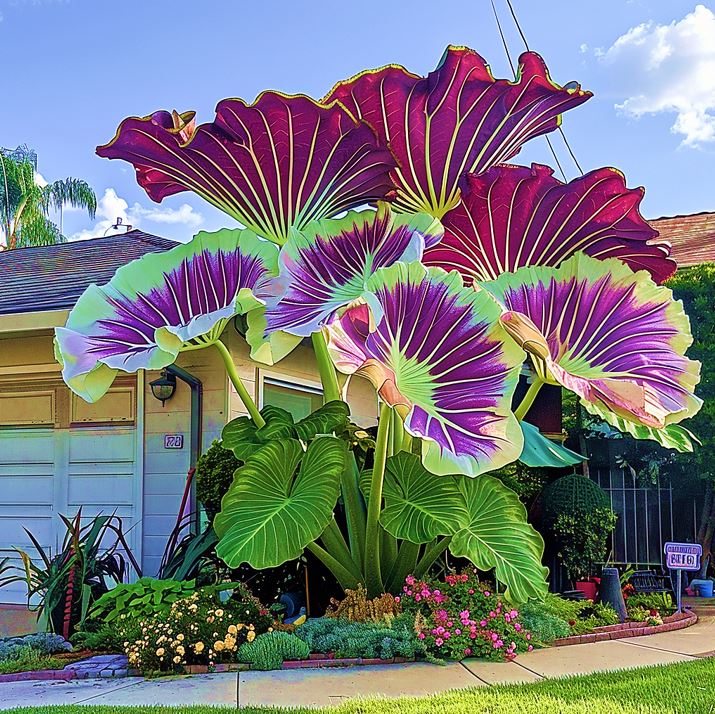
The ‘Thailand Giant Strain’ provides a remarkable example of how carefully chosen plants can significantly impact the balance and biodiversity of a garden ecosystem. This highlights the importance of understanding plant-animal interactions when designing a garden.
By creating a diverse and thriving environment, the ‘Thailand Giant Strain’ also helps to promote resilience within the ecosystem. The more species that inhabit the garden, the greater the overall health and ability to withstand environmental disturbances. A healthy, balanced ecosystem is far more resilient to the vagaries of weather patterns, pests, and diseases than a less diverse one. The ‘Thailand Giant Strain’ is a testament to the concept that beauty and functionality can go hand in hand – promoting biodiversity while offering stunning aesthetics.
A Culinary and Cultural Heritage: Colocasia gigantea ‘Thailand Giant Strain’ Beyond the Garden

Beyond its ornamental value, Colocasia gigantea ‘Thailand Giant Strain’ carries a rich cultural heritage and a vital role in the culinary traditions of South Asia. The edible tubers, known as taro, are a staple food source in many regions, bridging the gap between horticulture and nourishment.
Taro Root: A Staple Food with Deep Historical Roots
The tubers of Colocasia gigantea have been a valued source of carbohydrates and nutrients for centuries in South Asian cultures. Taro has been cultivated for its edible corms, rich in carbohydrates, vitamins, and minerals, providing nutrition to communities throughout history.
The starchy tubers are prepared in a variety of ways, ranging from boiled and mashed to roasted or fried. They are a staple food in many regions, forming the foundation of traditional dishes that are passed down through generations. Understanding the history and cultural significance of this plant gives us a deeper appreciation for its multifaceted nature.
From Landscape to Table: Sustainable Gardening and Food Security
The fact that Colocasia gigantea ‘Thailand Giant Strain’ can serve both as a decorative garden element and as a vital food source is a testament to the concept of sustainable gardening. This dual purpose emphasizes the potential for gardens to simultaneously beautify and provide a source of nourishment.
In an era increasingly focused on food security and sustainable living, understanding the role of plants like Colocasia gigantea ‘Thailand Giant Strain’ becomes more critical than ever. Incorporating edible plants into gardens can lead to a greater sense of self-sufficiency and a deeper connection to the source of our food. Promoting sustainable practices in gardening can contribute to resilience and lessen our reliance on industrial food systems.
Cultivating a Connection: Cultural Practices and Environmental Awareness
Colocasia gigantea ‘Thailand Giant Strain’ prompts us to consider the strong connection between human cultures and the plant world. It highlights how plants have been integral to the livelihoods and cultural development of communities across the globe.
Respecting the cultural and historical significance of plants, like utilizing the ‘Thailand Giant Strain’ not only for beautification but also for nutrition, creates a greater understanding of the value of biodiversity and its role in communities. This perspective inspires a more holistic approach to horticulture, integrating ecological and cultural dimensions into gardening practices. We are reminded that our gardens are not only aesthetic spaces; they are historical sites, reflecting the cultural and ecological heritage of a region.
Cultivating Success: Understanding the Needs of Colocasia gigantea ‘Thailand Giant Strain’
To successfully cultivate Colocasia gigantea ‘Thailand Giant Strain’, gardeners need to understand its specific environmental requirements. This involves replicating its natural habitat to create the optimal conditions for healthy growth and development.
The Tropical Origins: Mimicking the Native Environment
Colocasia gigantea is native to tropical regions, where it thrives in warm, humid conditions with ample moisture. Replicating these conditions is essential for cultivating this magnificent plant, especially in regions with colder climates.
Understanding the plant’s origin sheds light on its inherent needs – consistent moisture, fertile soil, and warmth. For example, providing adequate drainage in regions with heavy rainfall is crucial, while ensuring proper insulation during colder months might be necessary in temperate climates.
Moisture and Soil: The Foundation for Growth
Colocasia gigantea ‘Thailand Giant Strain’ thrives in moist, well-drained soil that is rich in organic matter. Maintaining consistent moisture levels is critical for the health and vigor of the plant.
However, it’s also crucial to avoid waterlogged conditions, which can lead to root rot. A balanced approach that mimics the natural environment of the plant is key. The soil should be rich and fertile, providing the plant with essential nutrients and ideal drainage. Organic matter can be incorporated into the soil, creating a more fertile and receptive growing environment for the plant.
Light and Temperature: Cultivating Optimal Conditions
While tolerant of varying light conditions, this plant thrives in partial shade, particularly in warmer regions. Direct, intense sunlight can burn the large leaves.
Moreover, providing a warm environment is critical for its healthy development. Understanding the temperature and light requirements helps to avoid stresses that can hinder growth or even lead to dormancy in regions with cold winters. Optimizing temperature and light conditions encourages vigorous growth and healthy development of the ‘Thailand Giant Strain’, promoting its full potential and visual magnificence.
Conclusion
Colocasia gigantea ‘Thailand Giant Strain’ is more than a plant; it is a symbol of nature’s grandeur, a testament to ecological harmony, and a reflection of rich cultural traditions. It captivates us with its sheer size, its ability to transform spaces into thriving ecosystems, and its role as a source of sustenance and inspiration. In exploring the multifaceted world of this remarkable cultivar, we are reminded of the interconnectedness of life and the importance of both celebrating natural beauty and fostering a deeper understanding of our relationship with the plant world. The journey of Colocasia gigantea ‘Thailand Giant Strain’ allows us to appreciate its functional potential, its aesthetic appeal, and its historical and cultural value, encouraging us to cultivate a more holistic perspective within our home landscapes and our understanding of environmental stewardship. Through the lens of this singular species, we recognize the potential of gardens to not only be visually captivating but also to serve as educational and sustainable spaces that contribute to a better future for ourselves and generations to come.
